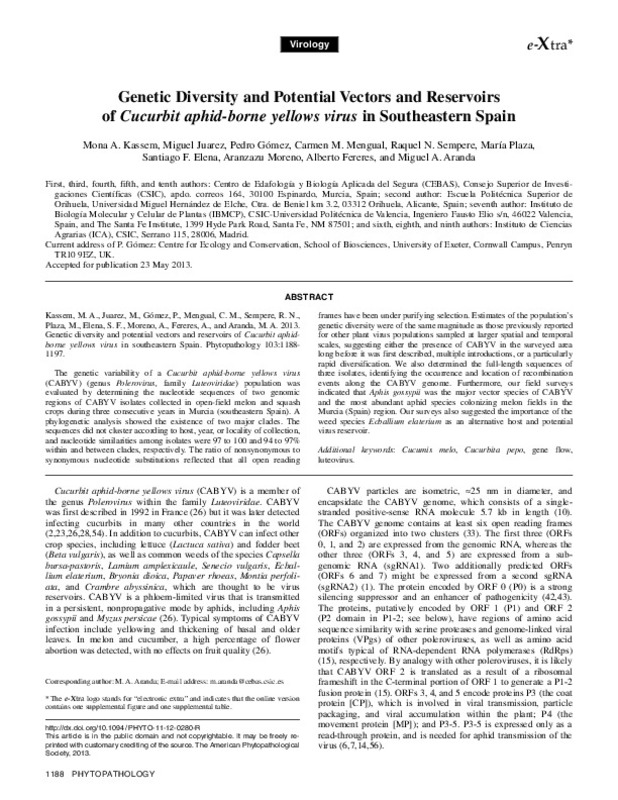Kassem, MA.; Juarez, M.; Gómez, P.; Mengual, CM.; Sempere, RN.; Plaza, M.; Elena Fito, SF.... (2013). Genetic diversity and potential vectrors and reservoirs of Cucurbit aphid-borne yellows virus in southeastern Spain. Phytopathology. 103(11):1188-1197. https://doi.org/10.1094/ PHYTO-11-12-0280-R
Por favor, use este identificador para citar o enlazar este ítem: http://hdl.handle.net/10251/83305
|
Título:
|
Genetic diversity and potential vectrors and reservoirs of Cucurbit aphid-borne yellows virus in southeastern Spain
|
|
Autor:
|
Kassem, Mona A.
Juarez, Miguel
Gómez, Pedro
Mengual, Carmen M.
Sempere, Raquel N.
Plaza, María
Elena Fito, Santiago Fco
Moreno, Aranzazu
Fereres, Alberto
Aranda, Miguel A.
|
|
Entidad UPV:
|
Universitat Politècnica de València. Instituto Universitario Mixto de Biología Molecular y Celular de Plantas - Institut Universitari Mixt de Biologia Molecular i Cel·lular de Plantes
|
|
Fecha difusión:
|
|
|
Resumen:
|
[EN] The genetic variability of a Cucurbit aphid-borne yellows virus (CABYV) (genus Polerovirus, family Luteoviridae) population was evaluated by determining the nucleotide sequences of two genomic regions of CABYV isolates ...[+]
[EN] The genetic variability of a Cucurbit aphid-borne yellows virus (CABYV) (genus Polerovirus, family Luteoviridae) population was evaluated by determining the nucleotide sequences of two genomic regions of CABYV isolates collected in open-field melon and squash crops during three consecutive years in Murcia (southeastern Spain). A phylogenetic analysis showed the existence of two major clades. The sequences did not cluster according to host, year, or locality of collection, and nucleotide similarities among isolates were 97 to 100 and 94 to 97% within and between clades, respectively. The ratio of nonsynonymous to synonymous nucleotide substitutions reflected that all open reading frames have been under purifying selection. Estimates of the population's genetic diversity were of the same magnitude as those previously reported for other plant virus populations sampled at larger spatial and temporal scales, suggesting either the presence of CABYV in the surveyed area long before it was first described, multiple introductions, or a particularly rapid diversification. We also determined the full-length sequences of three isolates, identifying the occurrence and location of recombination events along the CABYV genome. Furthermore, our field surveys indicated that Aphis gossypii was the major vector species of CABYV and the most abundant aphid species colonizing melon fields in the Murcia (Spain) region. Our surveys also suggested the importance of the weed species Ecballium elaterium as an alternative host and potential virus reservoir.
[-]
|
|
Palabras clave:
|
Curcumis melo
,
Cucurbita pepo
,
Gene flow
,
Luteovirus
|
|
Derechos de uso:
|
Reserva de todos los derechos
|
|
Fuente:
|
Phytopathology. (issn:
0031-949X
) (eissn:
1943-7684
)
|
|
DOI:
|
10.1094/ PHYTO-11-12-0280-R
|
|
Editorial:
|
American Phytopathological Society
|
|
Versión del editor:
|
http://doi.org/10.1094/PHYTO-11-12-0280-R
|
|
Código del Proyecto:
|
info:eu-repo/grantAgreement/f SéNeCa//11934%2FPI%2F09/
info:eu-repo/grantAgreement/MICINN//AGL2009-07552/ES/Traduccion De Rnas De Virus De Plantas Independiente De Cap: Analisis Del Modelo Experimental Mnsv%2FMelon Y Aplicaciones Biotecnologicas/
|
|
Agradecimientos:
|
This work was supported by grants 11934/PI/09 (Fundacion Seneca de la Region de Murcia, Spain) and AGL2009-07552/AGR (Ministerio de Ciencia e Innovacion, Spain). M. Kassem was recipient of a fellowship from the Agencia ...[+]
This work was supported by grants 11934/PI/09 (Fundacion Seneca de la Region de Murcia, Spain) and AGL2009-07552/AGR (Ministerio de Ciencia e Innovacion, Spain). M. Kassem was recipient of a fellowship from the Agencia Espanola de Cooperacion Internacional-Ministerio de Asuntos Exteriores (AECI-MAE). We thank V. Truniger for critically reading the manuscript, M. C. Montesinos and B. Gosalvez for their excellent technical assistance, and M. Fon for checking the English.
[-]
|
|
Tipo:
|
Artículo
|








